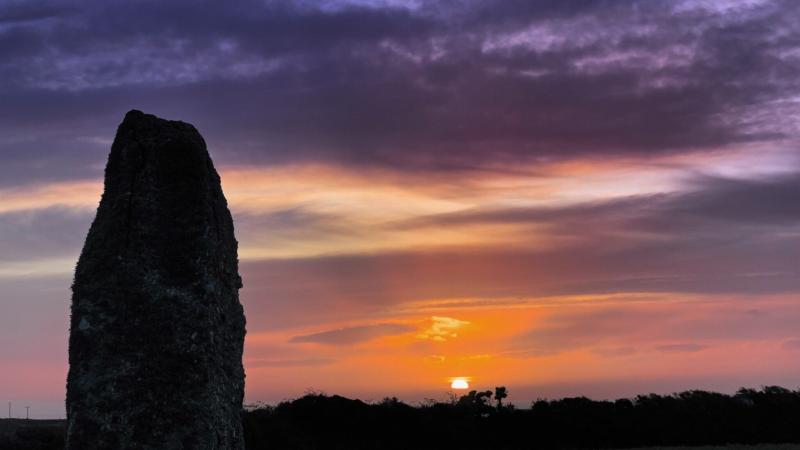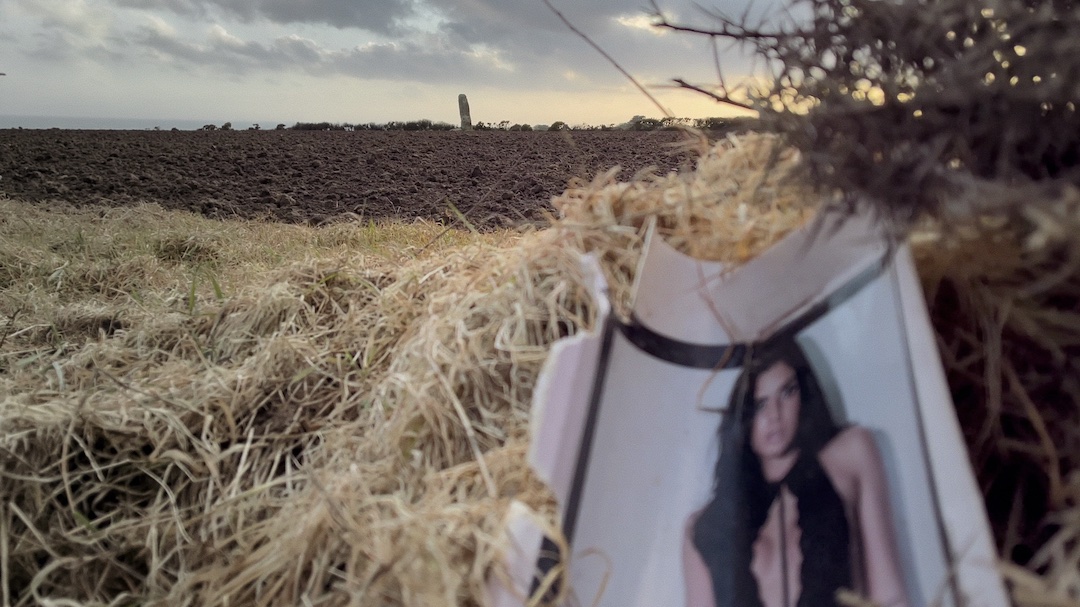A Year in a Field review - exemplary eco-doc | reviews, news & interviews
A Year in a Field review - exemplary eco-doc
A Year in a Field review - exemplary eco-doc
Filmmaker Christopher Morris keeps vigil near Land's End as the planet goes to hell

A shot of a dead field mouse sets the tone for this sobering “slow cinema” documentary, narrator-director Christopher Morris’s response, simultaneously aghast and philosophical, to the looming environmental catastrophe.
Rather than contemplate the decimation of the Amazon rain forests or the melting of the polar ice caps, Morris decided to spend a year filming the barley field that surrounds the 4,000-year-old Boscawen-Rôs East menhir, or standing stone, four miles north-east of Land’s End in Cornwall.
According to the late earth mysteries writer John Michell, the so-called Longstone and its fellow menhir were uprooted early in the 20th century; whereas Boscawen-Rôs East was restored to the middle of the field, Boscawen-Rôs West’s stump was built into the rocks of a typical Cornish hedge.
Between winter solstice 2020 and winter solstice 2021, Morris trained his camera on and around the former lichen-covered stone, though he also looked south to the English Channel. Passing container ships and a lorry on a distant road are the film’s only signs of contemporary human activity, aside from the wrappers and packaging that blow into the field.
Scorning the bipeds whose pollutants and burning of fossil fuels eliminated 69 per cent of monitored vertebrates between 1970 and 2018 and are massacring the insect population at rates of nine percent (terrestrial species) and eleven percent (freshwater) each year, Morris observes birds, cows, slugs, snails, an earthworm, and bugs going about their business. Nocturnally foraging mice, their eyes points of light in the night vision images, dart around or flinch when they spot the camera or its operator. A badger shows up, reminding me of two badgers I saw in rural Hertfordshire earlier this month, their carcasses shoved to the sides of the roads on which they were killed.
Morris marvels that he can’t name one winged insect with hair-thin limbs he shows dining on a leaf for several minutes; what seems uneventful to the viewer was existential for that creature in that moment in its brief life. The scene is part of the film’s effective scheme of parochialisation. As the field is a microcosm of the earth, so an insect’s work as a pollinator, decomposer, and feeder of wildlife is crucial to the ecosystem, the food web, life on earth. Watching it is humbling.
A Year in a Field’s glacial pacing can’t help but emphasise the beauty of what is being lost – Morris’s photography is sublime – but the beauty is inherent in nature’s communal organisation, nothing to do with aesthetics (not to minimise the loveliness of the pink, white, and yellow wildflowers glimpsed on screen). Underscored by stringed instrument music that veers between plaintive and grating, perhaps intentionally, the slowness is agitating because Morris contrasts it with the speed at which we’re imperilling the planet according to Einstein’s Doomsday Clock.
 Following the atomic bombings of Hiroshima and Nagasaki at the end of World War Two, the clock was initially set at seven minutes to midnight in 1947, midnight being the time of a hypothetical global catastrophe. By the pandemic year of 2021, the clock read one minute 40 seconds to midnight; as of now, it’s 90 seconds to midnight, the war in Ukraine adding to the environmental toll taken by the climate crisis.
Following the atomic bombings of Hiroshima and Nagasaki at the end of World War Two, the clock was initially set at seven minutes to midnight in 1947, midnight being the time of a hypothetical global catastrophe. By the pandemic year of 2021, the clock read one minute 40 seconds to midnight; as of now, it’s 90 seconds to midnight, the war in Ukraine adding to the environmental toll taken by the climate crisis.
Among the trash Morris found and photographed in the field was a Snickers wrapper and a packet (pictured above) for an item of lingerie seductively modelled by a young woman in the label photo. Building his metaphor, Morris notes that the undies in question (an Ann Summers “luxe bodysuit”) were manufactured from vegetation-based carbon turned into synthetic fibres in China and travelled 6000 miles in a container before the bag came to adorn a Cornish barley field.
He says that the world’s 100,000 cargo ships – which are powered by toxic tarry bunker fuel, illegal for use on land but not at sea – emit a billion tons of greenhouse gases every year: a seductive statistic if ever there was one. Of 100 billion items of clothing made annually, Morris adds, 60 billion are discarded within a year. Perhaps not to overwhelm us, he doesn’t quantify the damage done by the airplane contrails he shows streaking the sky above Cornwall in heat-trapping clouds.
The Longstone might inspire awe for its longevity and Celtic-Druidic mystique, but as A Year in a Field draws to a close Morris queries what it represents. Boscawen-Rôs means “the place of the elder on the heath,” but elder trees no longer stand there. At the start of the Bronze Age, the elders were cut down and burned as part of the tin-smelting process and the local rivers polluted.
“Maybe the Longstone is a fuck-you to nature,” Morris concludes ruefully, “a symbol of human dominance [made] by a civilisation that sidestepped nature to build a world of make-believe.” Not the least of the documentary’s strengths is the realisation that such a world is as sustainable as an unnamed insect, fragility personified, getting its fill on a leaf.
The future of Arts Journalism
You can stop theartsdesk.com closing!
We urgently need financing to survive. Our fundraising drive has thus far raised £49,000 but we need to reach £100,000 or we will be forced to close. Please contribute here: https://gofund.me/c3f6033d
And if you can forward this information to anyone who might assist, we’d be grateful.

Subscribe to theartsdesk.com
Thank you for continuing to read our work on theartsdesk.com. For unlimited access to every article in its entirety, including our archive of more than 15,000 pieces, we're asking for £5 per month or £40 per year. We feel it's a very good deal, and hope you do too.
To take a subscription now simply click here.
And if you're looking for that extra gift for a friend or family member, why not treat them to a theartsdesk.com gift subscription?
more Film
 After the Hunt review - muddled #MeToo provocation
Julia Roberts excels despite misfiring drama
After the Hunt review - muddled #MeToo provocation
Julia Roberts excels despite misfiring drama
 Ballad of a Small Player review - Colin Farrell's all in as a gambler down on his luck
Conclave director Edward Berger swaps the Vatican for Asia's sin city
Ballad of a Small Player review - Colin Farrell's all in as a gambler down on his luck
Conclave director Edward Berger swaps the Vatican for Asia's sin city
 London Film Festival 2025 - Bradley Cooper channels John Bishop, the Boss goes to Nebraska, and a French pandemic
... not to mention Kristen Stewart's directing debut and a punchy prison drama
London Film Festival 2025 - Bradley Cooper channels John Bishop, the Boss goes to Nebraska, and a French pandemic
... not to mention Kristen Stewart's directing debut and a punchy prison drama
 London Film Festival - from paranoia in Brazil and Iran, to light relief in New York and Tuscany
'Jay Kelly' disappoints, 'It Was Just an Accident' doesn't
London Film Festival - from paranoia in Brazil and Iran, to light relief in New York and Tuscany
'Jay Kelly' disappoints, 'It Was Just an Accident' doesn't
 Iron Ladies review - working-class heroines of the Miners' Strike
Documentary salutes the staunch women who fought Thatcher's pit closures
Iron Ladies review - working-class heroines of the Miners' Strike
Documentary salutes the staunch women who fought Thatcher's pit closures
 Blu-ray: The Man in the White Suit
Ealing Studios' prescient black comedy, as sharp as ever
Blu-ray: The Man in the White Suit
Ealing Studios' prescient black comedy, as sharp as ever
 The Woman in Cabin 10 review - Scandi noir meets Agatha Christie on a superyacht
Reason goes overboard on a seagoing mystery thriller
The Woman in Cabin 10 review - Scandi noir meets Agatha Christie on a superyacht
Reason goes overboard on a seagoing mystery thriller
 London Film Festival 2025 - crime, punishment, pop stars and shrinks
Daniel Craig investigates, Jodie Foster speaks French and Colin Farrell has a gambling habit
London Film Festival 2025 - crime, punishment, pop stars and shrinks
Daniel Craig investigates, Jodie Foster speaks French and Colin Farrell has a gambling habit
 I Swear review - taking stock of Tourette's
A sharp and moving tale of cuss-words and tics
I Swear review - taking stock of Tourette's
A sharp and moving tale of cuss-words and tics
 A House of Dynamite review - the final countdown
Kathryn Bigelow's cautionary tale sets the nuclear clock ticking again
A House of Dynamite review - the final countdown
Kathryn Bigelow's cautionary tale sets the nuclear clock ticking again
 theartsdesk Q&A: Idris Elba on playing a US President faced with a missile crisis in 'A House of Dynamite'
The star talks about Presidential decision-making when millions of lives are imperilled
theartsdesk Q&A: Idris Elba on playing a US President faced with a missile crisis in 'A House of Dynamite'
The star talks about Presidential decision-making when millions of lives are imperilled

Add comment